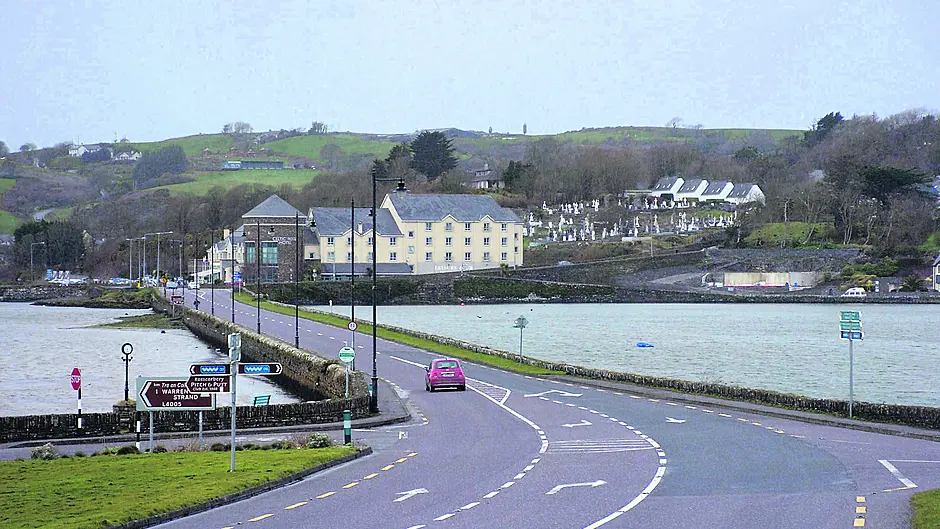The attractive causeway in Rosscarbery was built in response to the attempted French landing in Bantry Bay in 1796 and was originally part of a ‘military road’, writes Niamh Hayes
WHAT do Charles Stewart Parnell, Michael Collins, Jeremiah O’Donovan Rossa and Tom Barry all have in common?
Besides all of them being prominent figures in the fight for Irish independence, they all travelled over the causeway in Rosscarbery at significant times in their lives.
This year, 2020, this causeway is marking its 200th anniversary, prompting these recollections.
Charles Stewart Parnell passed along the causeway on a sidecar when campaigning during an election in 1880, while Michael Collins passed on his return journey to Cork on that fateful day of August 22, 1922, before being killed in an ambush in Béal na mBláth.
Local hero Jeremiah O’Donovan Rossa received a tremendous welcome at the causeway when he returned to Ireland in 1904, having moved to New York after being banished by the British Government, and the famous flying column, Tom Barry, traversed the causeway many times.
And, in more recent times, the O’Donovan brothers brieflyy stopped off at the Celtic Ross Hotel on the causeway on their victorious return from the Olympics, to an appropriate heroes’ welcome.
These are not the only well-known figures to have travelled the causeway, which has become a place of much activity and celebration over its 200 years of existence.
Known at the time as Post Office Causeway, construction of it started in 1814 and it was built across Rosscarbery estuary as part of the new Post Office Road between Cork and Skibbereen.
Mick O’Mahony of the Rosscarbery Historical Society says that the causeway was built in response to the near fiasco of the attempted French landing in Bantry Bay in 1796.
‘The present-day causeway was described as a military road. The English authorities in Cork were frustrated at how long it took to bring reinforcements to Bantry through a rough country with inferior roads,’ says Mick.
They immediately set about building a proper military road from Cork city westwards, and part of that included the causeway in Rosscarbery.
‘In addition to the road, a jetty for the mooring of fishing boats was provided on the south side of the road, and later a dwelling house was built centre ways, a family named McCarthy lived here,’ adds Mick.
The house is no longer on the causeway and there is actually some evidence that suggests that there was a road in the area much earlier than 1820. An English visitor, writing in 1814, described driving over a causeway traversing the inner harbour connected to the mainland at the western end by a bridge.
Now, 200 years later, the structure of the causeway remains in good condition, illustrating the impressive design, engineering and construction process of the time.
Cork County Council dammed the bridge at the causeway in the 1970s to permanently flood the inland side of the bay, which prevented the water level from dropping too low. The resulting lagoon is now in full use with the Lagoon Activity Centre and Rosscarbery Rowing Club being avid users of the waterway.
A mini ecosystem also evolved from the damming and as a result, sea snails and worms, krill, shrimp, crab, pollock, mullet, silver eel, sand fish, rock fish and bass are all found there.
These attract bigger predators such as sea otters and an extensive array of bird life and species of duck.
‘The causeway has been a place of celebrating the victories of the Carbery Rangers teams over the years,’ says Mick. ‘Bonfires have been a common site here. Horse racing was also held along the causeway in conjunction with the annual regatta. In recent years the County Council provided public lighting which makes the causeway a safe place for walking and jogging.’
To commemorate the 200th anniversary, a number of events are in the pipeline and the year of celebration started with the lighting up of the causeway on New Year’s Eve by candlelight.
The events are being organised by the Causeway 200 Committee which is made up of representatives from a range of groups within the local area including, the Community Council, Historical Society, Tidy Towns, Business Association, Steam Runners AC, Rowing Club, Carbery Rangers and the Celtic Ross Hotel.
Fiona Calnan, chairperson of the committee, said: ‘We are planning three or four big events to commemorate the anniversary and then events which are already held in Rosscarbery will give a nod to it.’
‘Participants of the Surf Turf ‘n’ Tar race will be given a special commemorative medal, while during the summer we will hold an old-time parade across the causeway,’ she added.
The Historical Society, which holds a number of talks throughout the year, will dedicate one of these to teaching the public about the history of the causeway.
They also hope to produce a 2021 calendar which will be made up of 12 photographs taken by members of the public, which will have won a monthly photo competition that will be running all year. The photographs can be old or new, just as long as they put a spotlight on the causeway. These photos will be exhibited in the Celtic Ross Hotel at the end of the year and it is hoped that the calendar will be launched at a gala function.
Anyone with any information regarding the history of the causeway is asked to get in touch with the committee by emailing [email protected]
Subscribe to the Southern Star's YouTube channel, like us on Facebook and follow us on Twitter and Instagram for all the latest news and sport from West Cork.








